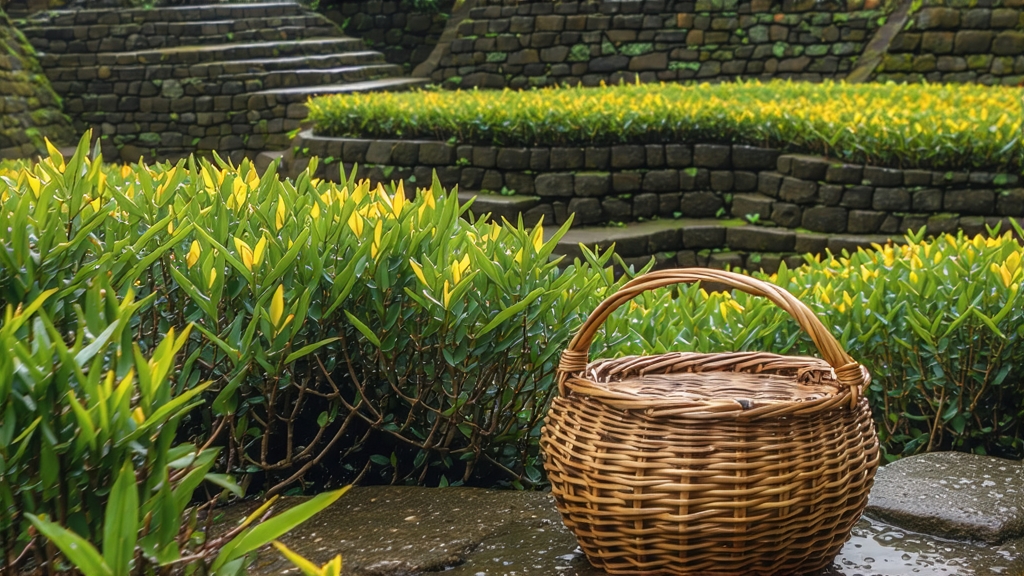
High among the perennially cloud-wrapped summits of Mt. Mengding in Sichuan Province, a tea once reserved for emperors still unfurls its down-covered buds each early April. Meng Ding Huang Ya—literally “Meng Summit Yellow Bud”—is the least-celebrated yet most aristocratic member of China’s micro-category of yellow teas. While green tea is arrested quickly and raw, and dark tea is left to ferment for months, yellow tea walks a tightrope between the two: it is deliberately “smothered” in its own gentle heat so that the leaf oxidizes by a mere whisper, acquiring a luminous straw-gold liquor and a fragrance that recalls fresh orchards after rain. To international drinkers who think they know Chinese tea only in greens and blacks, Meng Ding Huang Ya offers a quiet revelation—an entire tradition hidden inside a single, silky bud.
Historical whispers
The first written record appears in a Tang-dynasty edict of 724 CE, instructing the governor of Yazhou to send “one hundred cakes of Mengding little-bud” to Chang’an. By Song times the tea had become so coveted that court officials sealed the mountain passes each spring to prevent commoners from picking ahead of the imperial harvest. A Ming-era stele still standing at the mountain gate lists Meng Ding Huang Ya among the “nine tributes never to be taxed,” meaning every gram went to the throne. When the last Qing emperor abdicated in 1912, the mountain monks quietly kept the craft alive in temple kitchens, passing it to lay farmers only after 1950. Thus, while the West discovered Keemun and Dragon Well in the early twentieth century, yellow tea remained a domestic secret until small lots appeared at the 1985 Brussels Food Fair, stunning European cuppers who could not classify its color or aroma.
Micro-ecology and leaf architecture
Mt. Mengding rises 1 456 m where the Sichuan basin meets the Tibetan plateau. Night temperatures plunge while daytime warmth lingers under a 70 % relative humidity cloak. The cultivar of choice is the local “Mengding #9,” a tea-camellia variety that evolved smaller cell vacuoles and extra palisade layers—biological shorthand for buds that stay tender yet concentrate savory amino acids. Picking occurs only between the Qingming and Grain Rain solar terms (roughly April 5–20) when each bud is still a fish-leaf—tight, 12–15 mm long, and sheathed in silvery down. One kilogram of finished Huang Ya demands 72 000 such buds, all plucked before nine in the morning so that dew acts as a natural protective film against mechanical bruising.
The yellowing alchemy
Unlike green tea’s immediate kill-green, Meng Ding Huang Ya undergoes a three-stage “sealed yellowing” that can last five calendar days.
- Pan-firing at 160 °C for 3 minutes deactivates roughly 70 % of polyphenol oxidase, but the leaf is removed while still limp and warm.
- Hot-wrap resting: the leaves are piled 3 cm deep inside linen bags that retain 45 °C for two hours; the core temperature is allowed to drop only to 38 °C before the pile is gently turned. During this interval chlorophyll degrades into pheophytin, conferring the characteristic primrose hue.
- Oven-yellowing: the semi-dry leaf is loaded on bamboo trays sliding into a charcoal-fed clay oven held at 55 °C and 65 % humidity for 40 hours. Technicians “read” the leaf every two hours; when the bud stem snaps cleanly and the surface feels like suede, the yellowing is judged complete.
A final low-temperature bake at 50 °C for one hour sets the aroma and reduces moisture to 5 %, ensuring a shelf life of three years if stored away from light.
Grades and leaf style
Meng Ding Huang Ya is classified into four ascending grades based on bud integrity and yellowing uniformity:
- Special Grade Imperial Needle: 100 % single buds, liquor the color of chardonnay, orchid-honey fragrance.
- Grade One Jade Sparrow: one bud and one unfolded leaf, brisk apricot note.
- Grade Two Mountain Rain: one bud and two leaves, mellow with a hint of roasted squash.
- Grade Three Valley Mist: larger leaf, still sweet but lighter; ideal for cold brew